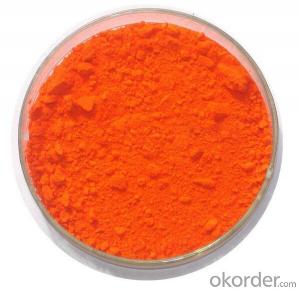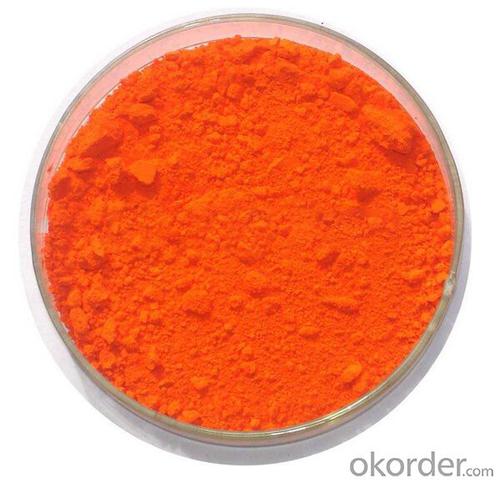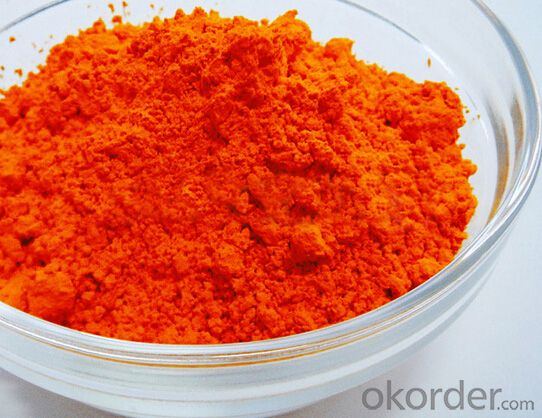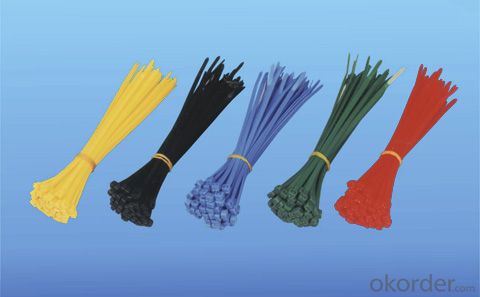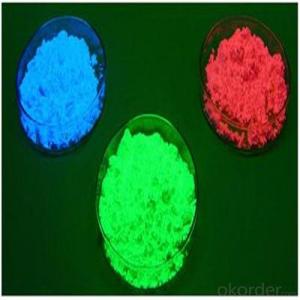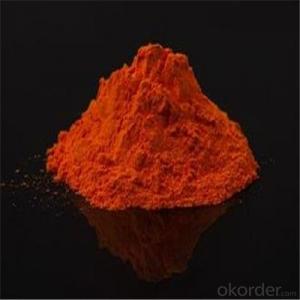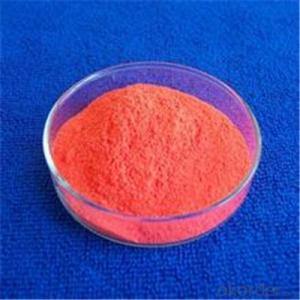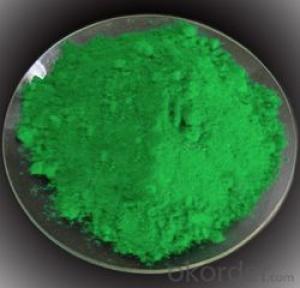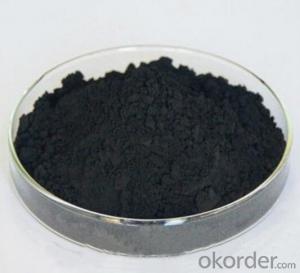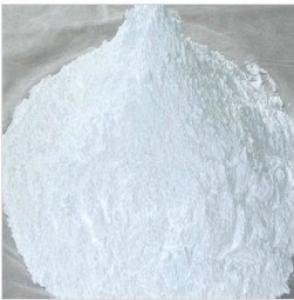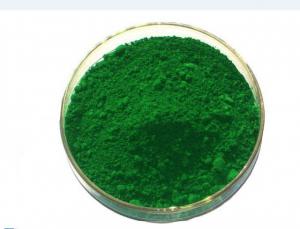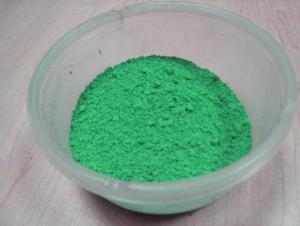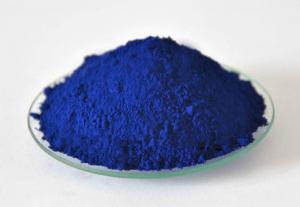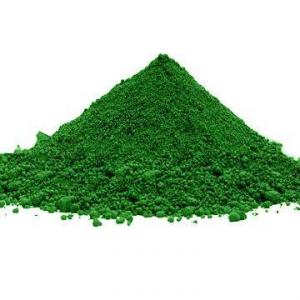Cadmium Orange Pigment Pigment Organic Powder
- Loading Port:
- Tianjin
- Payment Terms:
- TT OR LC
- Min Order Qty:
- 500 kg
- Supply Capability:
- 6000000 kg/month
OKorder Service Pledge
OKorder Financial Service
You Might Also Like
Cadmium Orange Specifications:
Products made by Powder Coating Pigments Manufacturer
- Excellent lightfastness resistance
- Weather resistance
- Tint strength
- Orange Pigment for Powder Description:
Chemical Name: Cadmium Orange
C.I.Name: Pigment orange 20
Chemical Components: Cd-Se-S
CAS No.: 12656-57-4
Cadmium Orange Main Technical Data:
Volatile content at 105℃: | ≤0.5% |
Soluble salts:
| ≤0.5% |
Residue on 325 mesh sieve: | ≤0.5% |
Features | The inclusion series is a kind of unpolluted pigment, compared with traditional Se. Red pigment, which is heat-resistant and high-colored. |
Usage | Mainly used in Tiles, Sanitary and Daily Ceramic producing, Offset Ink, Water base Ink , Textile Printing, Plastic etc.
|
Packing Details | 25kg/bag, 40bag/pallet, woven bag with inner plastic, or customized.
|
Delivery Time | 1-2 weeks after the confirmed order
|
Payment Term | L/C, T/T |
Cadmium Orange Advantages:
Non-flammable, non-corrosive, non-explosive.
Excellent coloring strength, good lightfastness, weather resistance, excellent hiding power and non-migratory, its’ color range from yellow through orange to purple reddish orange.
Cadmium Orange Applications:
Coating: Wall Coating, Powder Coating
Plastics: Masterbatch ,Engineering Plastics, PVC
Ceramics
Glass
Rubber
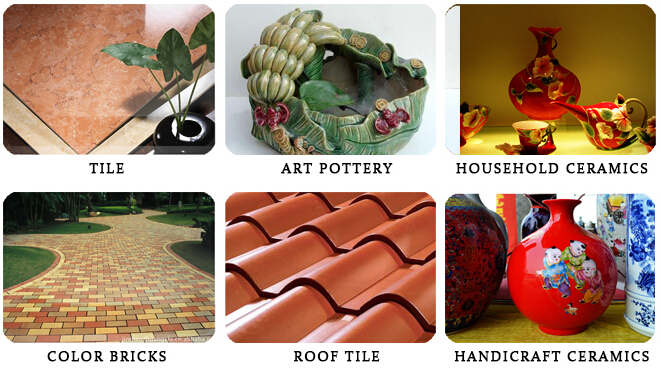


- Q: thank you very much for your help!
- This Site Might Help You. RE: what is the role of photosynthetic pigments in plants? thank you very much for your help!
- Q: how are pigments classified?
- because pigment is want gives us skin tone.
- Q: Please help me answer these Genetics problems. These are the problems that was assigned in the previous exams, but the professor doesn't provide the answer keys or a review session to go over these.Pigment in the mouse is produced only when the C allele is present. Individuals of the cc genotype have no color. if color is present, it may be determined by the A, a alleles. AA or Aa results in the agouti color, while aa results in the black color. In 3 crosses between agouti females whose genotypes are unknowns and males of the aacc genotype, the following phenotypic ratios were obtained. Female 1: 8 agouti 8 colorlessFemale 2: 4 agouti 5 black 10 colorless
- interior the 1st bypass AACC x aacc, discern a million will produce all AC gametes and discern 2 ac. Your F1 will all be AaCc. As all have the C allele they are going to be pigmented and as they're Aa they're going to all be agouti. Your F1 bypass is AaCc x AaCc. each and each discern can produce 4 gametes AC, Ac, aC, ac. To get all the genotypes you would be able to desire to entice a 4 x 4 Punnett sq.. each and each column and each and each row has between the 4 gametes in it and the cells comprise the blended genotypes. in case you count type up your genotypes you will discover 9 comprise the two A and C, those are agouti, 4 comprise cc, and all of those would be white regardless of the genotype at A, 3 comprise aa and C, those will all be black. So your phenotypic ratio would be 9:4:3 agouti: white: black the subsequent 3 crosses are all attempt crosses - you employ a recessive discern to artwork out the genotype of the different discern. a million. As lots of the offspring are colourless, you be attentive to that the two mothers and dads carry the c allele, as you pick cc for colourless mice. As there are no black mice, there is not any a allele interior the mum, as no aa offspring are produced. The bypass is AACc x aacc. woman gametes are AC or Ac and male gametes are all ac, offspring are the two AaCc or Aacc. 2. Is the opposite of bypass a million. There are black offspring so mom would desire to hold an a allele to furnish black mice, as there are no colourless ones, there is not any c allele interior the mum. you could write down the bypass and the F2 effect now. 3. This time all hues are produced, so the mum would desire to hold the two a and c alleles. Her genotype is AaCc, she would be able to offer 4 gametes as interior the 1st bypass and you will artwork out the resultant genotypes and phenotypes interior the F2.
- Q: What does the word pigment mean?
- it means the color. like the pigment of your eyes could be green, blue, hazel. or the pigment of your skin. it's a fancy-pants word for color.
- Q: ive been watching a lot of makeup videos on youtube and a lot of the girls use mac pigments. what exactly are they and how are they different from regular eyeshadow? are they easier or more difficult to use?
- they are a loose powder like consistency, and they're just that.. they're super pigmented!!! ut i have about 26 pigments (: most are mac, some other brands.
- Q: what are the differences between colorfast and non colorfast pigments?
- I'm sure with enough research you will be able to find these answers and explanations in your text book. Or google them, maybe it will have pics to help describe if your more of a hands on learner. Good Luck.
- Q: Please and thank you, it doesn't say so on the website.
- Mac Pigment Ingredients
- Q: I have dyed my hair dark brown for months now it keeps fading because i've had bleach on before hand, so I need some advice on buying decent hair dyes for pre-pigmenting it so my hair dye stops fading out into a horrible gingery brown!
- Pre Pigmenting Will Help Prevent Fading But, You Said Your Hair Had Been Bleached Before. So, You May Need Some DEEP Protien Reconditioning Too. Start By Using A Good Protien Treatment After Every Shampoo. Then, Use A Color Treatment Like ARCtec (Found In Salons And Beauty Supplies) This Will Build-Up The Hair's Pigment Levels. There Are Also Pre-Color Treatments Like L'OREAL Pre-Color Primer, That Will Help Color To Take More Evenly And Last Much Longer. Also, Try MATRIX ForteThérapie Cera-Repair. It Contains Ceramides, Which Are The Glue That Hold Hair And Skin Cells Together. With The Internal Structure And Surface Cells On The Hair (The Cuticle) Reinforced, Your Color WILL Last Longer.
- Q: I was intrested in buying some pigments on ebay but they dont say the name they just say these nubers #68 #69 #93 do u no what pigment name they are u could serch it that might help thank you
- All mac pigments have a specific name and i had researched a bit and seen videos of people comparing the fake to the authentic pigments. I've seen fakes with a no. on it. Stay away from this seller and i strongly suggest buy it from a MAC store as most brushes, pigments, eyeshadows are fake on Ebay.
Send your message to us
Cadmium Orange Pigment Pigment Organic Powder
- Loading Port:
- Tianjin
- Payment Terms:
- TT OR LC
- Min Order Qty:
- 500 kg
- Supply Capability:
- 6000000 kg/month
OKorder Service Pledge
OKorder Financial Service
Similar products
Hot products
Hot Searches
Related keywords
